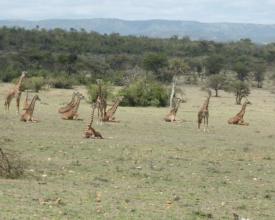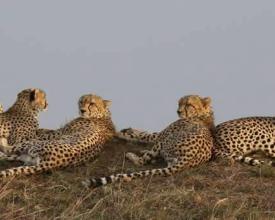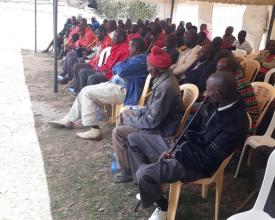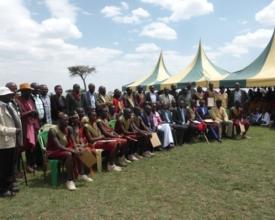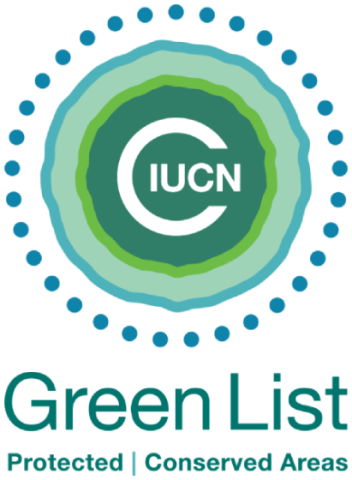
Modèle de conservation communautaire et de génération de revenus pour les populations locales
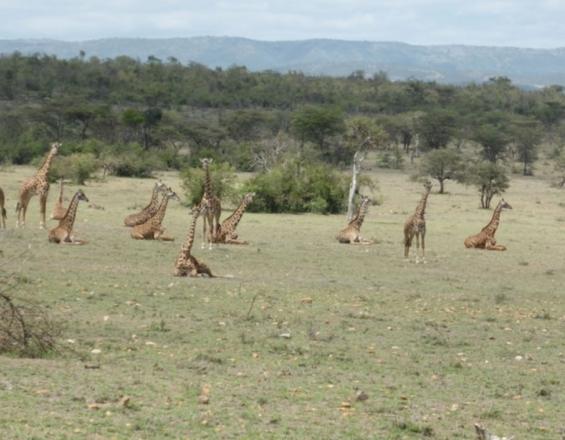
À la fin des années 1970, le Kenya a commencé à assister à une dégradation rapide des terres communautaires bordant les parcs nationaux et les réserves. Outre la menace qu'elle faisait peser sur la faune et la flore, cette dégradation menaçait également les moyens de subsistance des communautés, car elle entraînait une aggravation de la pauvreté et de la marginalisation écologique. La création de la Ol Kinyei Conservancy a été motivée par le désir d'enrayer cette dégradation et par la nécessité de conserver la faune et les habitats en établissant un partenariat avec les communautés vivant sur ces terres et en leur procurant des avantages réels et durables grâce à la faune et aux zones de nature sauvage. C'est le principe fondateur du modèle Porini, qui consiste à protéger les ressources indigènes pour générer des revenus. Dans ce modèle, il s'agit d'une entreprise d'écotourisme à faible densité dont les revenus sont reversés à la communauté pour l'inciter à préserver la santé de l'écosystème. Ce modèle est aujourd'hui largement accepté comme une solution de conservation bénéfique pour les populations et l'environnement et il est utilisé dans plusieurs autres endroits autour de Maasai Mara et dans le reste du Kenya.
Contexte
Défis à relever
La solution répond aux défis de la dégradation de l'environnement qui conduit à la destruction des habitats et à la perte de biodiversité qui se manifeste par un déclin massif des populations d'animaux sauvages. C'est particulièrement vrai pour les espèces de la grande faune qui ont besoin de vastes étendues. Les défis sociaux comprennent l'absence de bénéfices des terres communautaires bordant les zones protégées et la pauvreté associée causée par les conflits fréquents entre l'homme et la faune, les hommes et les animaux étant en concurrence pour des ressources rares.
Les propriétaires terriens sont donc contraints de subdiviser et de clôturer leurs terres, ce qui les rend économiquement non viables et également impropres à la conservation, ce qui constitue une perte pour les communautés, la faune et l'environnement. Le principal défi économique est la pauvreté, car les modèles formels de conservation ne permettent pas aux communautés de tirer des revenus directs de la faune et des parcs nationaux, qui sont la propriété des gouvernements nationaux et locaux, alors que les terres bordant les parcs nationaux sont naturellement mieux adaptées à la faune qu'à l'agriculture.
Emplacement
Traiter
Résumé du processus
- Identifier les zones critiques de dispersion de la faune sauvage dégradées par les clôtures, l'agriculture non durable et d'autres impacts. Ce travail est effectué par les parties prenantes et les chercheurs
- Engager les propriétaires fonciers à sélectionner et à louer des terres pour une zone de conservation, moyennant un loyer annuel par acre. Cette action est menée par les investisseurs du secteur privé et les communautés.
- conclure des partenariats de location avec les propriétaires fonciers et assurer la liaison avec les services gouvernementaux compétents pour veiller à ce que les baux soient légaux et enregistrés. Les communautés et les investisseurs s'en chargent.
- Recueillir des données sur les changements d'utilisation des terres et les dynamiques culturelles afin d'orienter l'élaboration des termes et conditions des baux. Les chercheurs s'en chargent.
- Mettre en œuvre des projets de surveillance et d'étude pour établir les changements de l'écosystème en termes de récupération de l'habitat et de renforcement des populations et des schémas de déplacement de la faune et de la flore. Cette tâche est effectuée par les chercheurs en collaboration avec la direction de la conservation.
- Utiliser les garanties des baux pour mettre en place des projets d'écotourisme qui génèrent des revenus pour compenser le coût des baux et des frais de fonctionnement de la réserve. C'est le résultat final qui assure le succès du modèle car il soutient toutes les autres activités. Ce sont les investisseurs du secteur privé qui s'en chargent
Blocs de construction
Partenariats communautaires
Les communautés sont au cœur de la solution. Elles sont propriétaires des terres et détiennent les droits de propriété sur celles-ci. Le problème est que les parcelles individuelles ne sont pas économiquement productives dans les zones de pâturage bordant les parcs nationaux. Lorsque les communautés réunissent leurs parcelles individuelles et forment une grande unité de conservation, celle-ci devient écologiquement viable pour la conservation et peut soutenir de grandes populations d'animaux sauvages et leurs besoins en matière d'habitat. Ces populations d'animaux sauvages peuvent alors soutenir les activités touristiques en attirant des visiteurs pour des safaris et des expéditions dans la nature, à un prix plus élevé, puisqu'il s'agit d'une zone plus exclusive que les parcs nationaux habituels. Cela génère à son tour des revenus qui permettent de payer aux propriétaires fonciers le coût de la non-utilisation de leurs terres, tout en créant d'autres opportunités de subsistance comme l'emploi et le soutien à d'autres projets communautaires comme l'éducation. L'objectif principal est de faire accepter le concept aux communautés et de leur faire admettre que, collectivement, elles ont plus à gagner à long terme en ne clôturant pas ou en n'aménageant pas leurs terres individuelles et en les abandonnant au profit d'un habitat pour la faune sauvage, avec les autres parcelles des autres membres de la communauté.
Facteurs favorables
Il doit y avoir de la bonne volonté et de la confiance entre la communauté et ses dirigeants, d'une part, et la communauté et les promoteurs de la zone de conservation, d'autre part. Le cadre juridique doit être en mesure de soutenir des accords de location qui garantissent aux propriétaires fonciers un recours juridique en cas de litige.
Leçon apprise
Les communautés indigènes ont de l'estime pour la faune et la flore sauvages et prendraient des initiatives pour leur conservation tant qu'il y a des avantages tangibles. Les populations sont également favorables à de véritables investissements basés sur les ressources naturelles qui soutiennent la conservation et apportent des solutions à la pauvreté et à la dégradation de l'environnement.
Les lois nationales qui soutiennent l'enregistrement des titres et des baux sont importantes car elles décentralisent la prise de décision des gouvernements nationaux vers les propriétaires fonciers individuels qui peuvent librement entamer des négociations avec les conservatoires. Cela facilite la prise de décision et permet aux communautés de prendre des décisions qui les concernent.
Collaboration avec les parties prenantes
La gestion des ressources naturelles et la mobilisation de la communauté nécessitent une interaction entre les parties prenantes qui sont essentielles au succès du modèle de conservation communautaire. Il y a ceux qui sont impliqués dans le plaidoyer et l'éducation de la communauté et leur contribution est très importante pour créer une prise de conscience et faciliter l'échange d'informations. Cela permet à la communauté de développer la confiance et d'apprécier sa contribution à la conservation de l'environnement et, en fin de compte, au développement économique. Les ONG jouent un rôle important dans le partage d'informations et de données et dans l'obtention d'un soutien international en matière de recherche et d'éducation. D'autres collaborateurs importants sont les gouvernements locaux et nationaux qui développent un cadre de collaboration avec les communautés et établissent des lignes directrices sur l'administration et la gestion de la faune sauvage dans les zones situées en dehors des parcs nationaux et des réserves conventionnelles. Le bureau gouvernemental des terres est très important car toutes les questions relatives à l'adjudication des terres lui sont confiées et il définit les lignes directrices pour les baux et les lois qui les régissent. Plus important encore, tous les secteurs de la communauté, y compris les jeunes et les femmes, doivent être impliqués dans la gestion de la conservation et le partage des bénéfices afin de s'assurer qu'ils sont intégrés dans la conservation et de garantir la durabilité de l'initiative.
Facteurs favorables
Il est nécessaire que les parties prenantes partagent la même vision et soient motivées par le désir impérieux de préserver l'environnement, y compris les grands mammifères les plus touchés par la dégradation de l'habitat. Les communautés doivent avoir un objectif commun basé sur le désir partagé d'améliorer les moyens de subsistance et de respecter la faune et la flore. La conservation nécessite un engagement continu avec les communautés afin qu'elles puissent apprécier leur contribution individuelle et collective.
Leçon apprise
La gestion des ressources et les questions communautaires sont complexes et la coopération de toutes les parties prenantes est importante. Les communautés sont très sensibles aux approches condescendantes des questions qui les concernent et doivent être impliquées avec beaucoup de patience et de finesse. Une approche importante consiste à faire appel aux dirigeants des communautés et à les sensibiliser, puis à leur permettre de discuter des problèmes avec les autres membres de la communauté et de répondre à leurs craintes, leurs espoirs et leurs ambitions. Les différentes parties prenantes ont des approches et des points de vue différents et il est toujours nécessaire d'avoir une équipe centrale qui prenne en compte les points de vue divergents et tente de les harmoniser avec les objectifs clés.
Enfin, le gouvernement est une partie prenante essentielle et le succès des efforts de conservation dépend largement de la bonne volonté et du soutien des gouvernements nationaux. Des objectifs clairement définis facilitent l'obtention d'un soutien lorsque le gouvernement apprécie la contribution du secteur privé et des communautés à la résolution des problèmes environnementaux et à la mise à disposition de terres supplémentaires pour la conservation.
Science et recherche
La recherche recueille des données sur l'environnement, l'histoire, les modes d'utilisation des sols et la politique gouvernementale. Cela permet de disposer d'une base pour prendre des décisions et pour impliquer les communautés, le secteur privé et le gouvernement. Dans notre cas, les chercheurs ont pu cartographier les couloirs de déplacement d'animaux tels que les éléphants, ainsi que les itinéraires et les saisons de migration d'autres animaux tels que les gnous. Il s'agit d'une ligne directrice utile pour l'établissement des limites de la zone de conservation et pour l'engagement des décideurs politiques et des communautés. La recherche fournit des informations utiles pour les campagnes publicitaires locales et internationales, ce qui permet de gagner facilement le soutien des parties prenantes.
La recherche est également utile pour établir des projections et effectuer un suivi afin de montrer les tendances des changements positifs et négatifs. Nous avons obtenu des données de recherche très utiles montrant un rétablissement spectaculaire de populations jusqu'alors en déclin de certaines espèces animales menacées, comme les grands félins. Il existe également des données socio-économiques qui montrent l'augmentation des revenus et l'amélioration des moyens de subsistance dans les communautés qui entourent la réserve grâce aux effets positifs de la réserve.
Facteurs favorables
Il doit y avoir une préoccupation nationale qui suscite l'intérêt pour la recherche de la part d'entreprises, d'institutions et d'individus réputés. Les chercheurs ont besoin de soutien et de facilitation pour mener à bien leurs travaux de recherche au sein de la population et dans l'environnement. Les acteurs concernés doivent être réceptifs à l'information scientifique et doivent manifester leur intérêt pour l'utilisation des résultats afin de prendre de meilleures décisions pour la population et le pays.
Leçon apprise
Les sujets de recherche doivent répondre à de véritables questions théoriques pour présenter un intérêt pour la science. Ce n'est qu'à cette condition qu'ils peuvent attirer le soutien nécessaire et l'accréditation des institutions d'enseignement qui rendent leur méthodologie acceptable sur le plan académique et leurs résultats suffisamment crédibles pour servir de base à la prise de décision et à la planification. Par exemple, il était important dans le Maasai Mara de montrer des preuves du déclin de la faune et de la flore, tout autant que de répondre à la question de savoir pourquoi cela se produisait. Il était également important de comprendre les tendances de l'utilisation des terres dans la grande région et de les relier à la diminution des habitats de la faune sauvage en raison de la subdivision des terres et de la recrudescence d'autres activités d'utilisation des terres telles que l'agriculture et le développement immobilier.
Il est également très important d'impliquer les communautés indigènes dans la conception des programmes et des objectifs de recherche et d'utiliser leurs connaissances historiques, culturelles et anecdotiques.
Leadership du secteur privé et des entreprises
Le succès du modèle repose principalement sur son principe de fonctionnement, conçu et dirigé par l'éthique et le caractère des dirigeants du secteur privé. Les politiques et processus communautaires et gouvernementaux sont encombrés par trop de bureaucratie et de léthargie et peuvent difficilement faire avancer un processus aussi complexe. En revanche, le leadership du secteur privé signifie que les personnes qui ont l'instinct et l'ambition des affaires peuvent voir l'opportunité de générer des revenus à partir de la terre en créant un arrangement gagnant-gagnant où la terre soutient la faune et la flore qui soutient le tourisme qui génère des revenus. Étant donné que le paiement des frais de location représente une charge énorme pour la conservation, les acteurs du secteur privé à la tête du projet doivent être en mesure de trouver des marchés et des personnes prêtes à payer pour faire l'expérience des sanctuaires communautaires de la vie sauvage qui profitent aux populations locales et à la vie sauvage. Les personnes du secteur privé qui développent et mettent en œuvre le modèle de conservation doivent être imprégnées d'une grande intégrité commerciale afin de pouvoir s'engager dans des partenariats légaux et honnêtes avec les communautés et entretenir des relations profitables à long terme. Cela permettra aux habitats et aux écosystèmes de prospérer et aux politiques de commercialisation de porter leurs fruits au fil du temps, car ces deux éléments nécessitent une planification à long terme, de la patience et de grands sacrifices de la part des deux parties.
Facteurs favorables
Un environnement commercial sûr et stable est nécessaire, car l'entreprise est à long terme, d'où la nécessité d'une stabilité à long terme et de politiques prévisibles. Il faut également des politiques d'investissement favorables qui encouragent les investissements du secteur privé axés sur le marché et les partenariats avec les populations locales et sur les terres. Ce modèle met fortement l'accent sur la conservation inspirée par l'entreprise, où la faune doit bénéficier directement à la population pour l'inciter à consacrer ses terres à la conservation.
Leçon apprise
La conservation des ressources naturelles et de la faune sauvage est entravée par le manque de terres, car les zones réservées à la faune sauvage par les gouvernements nationaux sont trop petites. La participation des communautés riveraines des parcs nationaux s'avère utile en utilisant leurs terres privées dans le cadre de la conservation. Toutefois, cela ne fonctionne que si les populations tirent un bénéfice direct de la faune et de la flore. La participation du secteur privé, qui identifie les opportunités commerciales permettant de combler le fossé des revenus, est primordiale et peut être utilisée dans de nombreuses autres régions et circonstances où les investisseurs du secteur privé s'engagent dans des partenariats rentables avec les communautés. Le secteur privé est le fer de lance de l'investissement et de la commercialisation, tandis que les communautés sont les gardiennes de la terre et des ressources naturelles en échange des revenus ainsi générés. Pour que cela réussisse, moins il y a de bureaucratie, mieux c'est, et l'arrangement doit être guidé uniquement par un partenariat commercial mutuel entre la population et les dirigeants du secteur privé, en collaboration avec d'autres parties prenantes, y compris les institutions et les départements gouvernementaux.
Ressources
Impacts
L'attrait principal de cette solution est qu'elle ne dépend pas du financement d'un donateur, mais plutôt d'un partenariat autopropulsé et mutuellement bénéfique entre une activité touristique privée et la communauté qui a volontairement mis de côté une partie de ses terres pour créer une réserve de faune et de flore qui leur profite. La réserve permet de réhabiliter des terres qui étaient auparavant dégradées et de créer un espace pour la régénération des populations d'animaux sauvages, y compris les grands mammifères, qui sont très menacés dans la plupart de leurs aires de répartition. L'augmentation de la faune dans les zones situées en dehors des parcs nationaux gouvernementaux soutient les efforts nationaux de conservation de la faune sans exercer de pression sur le gouvernement national en matière d'utilisation des terres et d'économie, en raison de sa durabilité. Les communautés tirent un revenu garanti de la location, sans que leurs terres soient soumises à la subdivision, à la fragmentation, à la clôture et à diverses utilisations des terres, y compris la culture et la déforestation, qui seraient contraires à la conservation. Outre le revenu direct de la location, les propriétaires fonciers bénéficient des emplois directs et indirects générés par les activités d'écotourisme et de gestion de la conservation. Le modèle offre également la possibilité aux personnes instruites des communautés de mener des actions d'éducation à l'environnement et de lancer des programmes communautaires qui feront connaître la réserve à la population et renforceront les effets positifs de la conservation.
Bénéficiaires
Les communautés sont les premières bénéficiaires car elles obtiennent des revenus directs et garantis. Le gouvernement est moins contraint de fournir des terres pour la conservation et des revenus à la population. La faune et l'écosystème sont également favorisés par l'augmentation de l'espace.
Objectifs de développement durable
Histoire
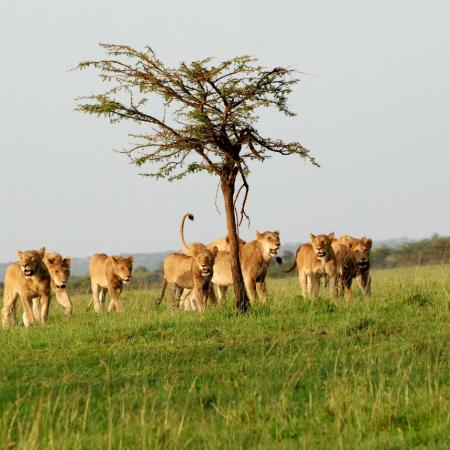
En décembre 2016, le président de Gamewatchers Safaris et fondateur de Ol Kinyei Conservancy, Jake Grieves-Cook, a reçu la mise à jour suivante de la part du chercheur principal du Mara Lion Project :
"Je tiens à souligner que nous avons constaté que la densité de lions était plus élevée dans toutes les réserves combinées que dans la réserve nationale. Je trouve cela tout à fait remarquable étant donné que (sur le plan écologique) les réserves sont relativement récentes. Naboisho, Ol Kinyei et OMC sont toutes des zones critiques pour les lions. OMC a la densité la plus élevée de toutes les zones protégées, ce qui est en grande partie le résultat de la densité de la rivière et des habitats favorables. Ol Kinyei a la deuxième plus grande densité de lions de toutes les zones protégées et est également un véritable "hotspot" de lions. Naboisho a une densité de lions plus faible, mais le nombre de lions y est encore très élevé. Je suppose que de nombreux touristes pensent d'abord à la réserve de Maasai Mara lorsqu'ils envisagent de partir en vacances, mais des documents comme celui-ci contribueront certainement à leur ouvrir les yeux sur la faune spectaculaire des zones protégées. Je suis pleinement conscient de l'énorme travail accompli par toutes les personnes impliquées dans les réserves et j'espère que ce rapport apportera des nouvelles positives, car les lions prospèrent certainement dans ces réserves.
Le fait qu'Ol Kinyei soit désormais considérée comme l'une des zones présentant les plus fortes densités de lions au Kenya, alors que leur population est en déclin dans la plupart des autres régions d'Afrique, est une source d'inspiration immense.
Cela montre l'importance de l'habitat pour les grands mammifères et constitue une preuve irréfutable de l'importance du modèle de conservation et de la manière dont il préserve les terres pour les animaux tout en générant des revenus pour les communautés.
Le message sous-jacent est que l'urbanisation et les changements dans l'utilisation des terres qui se produisent dans de nombreux endroits du Kenya et qui entraînent une perte d'habitat pour la faune et une forte diminution du nombre d'animaux sauvages peuvent être contrôlés de manière rentable. Au lieu de laisser les anciens pâturages devenir des zones densément peuplées ou clôturées et être occupées par des exploitations agricoles non viables, la mise en réserve de terres en tant que "Conservancies" est un moyen de fournir davantage d'habitats aux animaux sauvages et de leur donner un espace où ils peuvent vivre, en utilisant les revenus du tourisme pour payer les frais de conservation. Le nombre d'animaux sauvages a considérablement augmenté dans les réserves qui se sont développées dans des régions telles que Amboseli, Mara et Laikipia, et elles constituent un refuge pour de nombreuses espèces, en particulier pour les grands félins, les éléphants et les rhinocéros. Une véritable source d'inspiration pour la nature et les hommes

